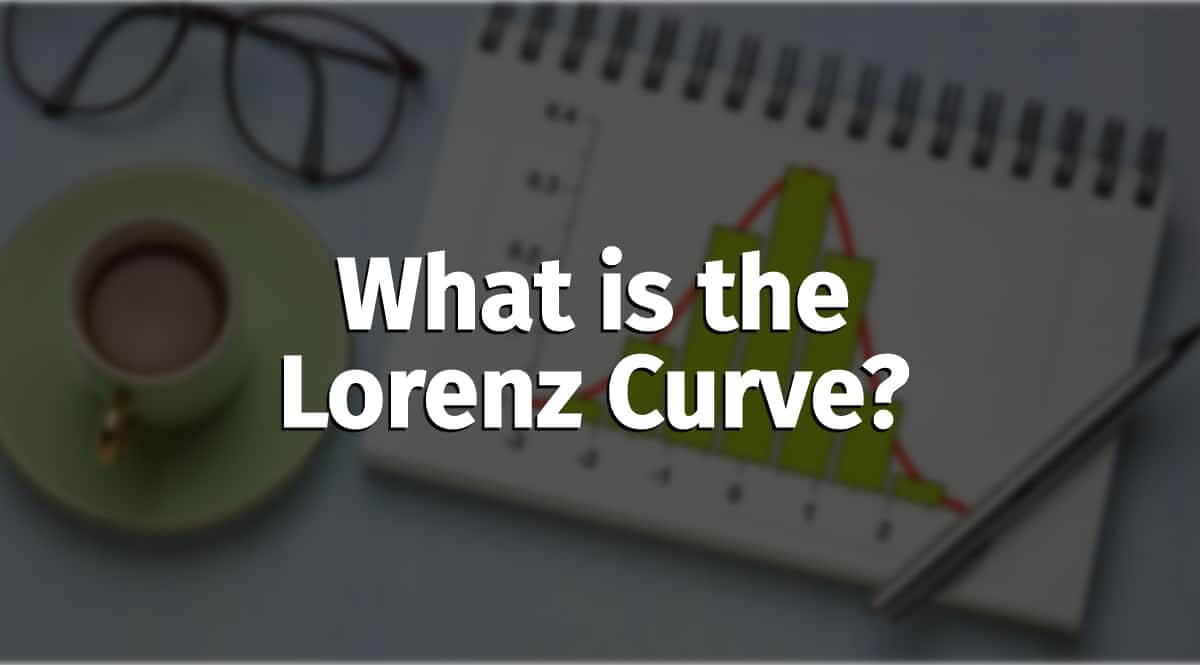What is the Lorenz curve, and how to draw It?
How to measure income inequalities within society? How do we know if inequalities are decreasing or increasing? One of the most common methods is using This curve.
What is the Lorenz curve?
A Lorenz curve, developed by American economist Max Lorenz in 1905, is a graphical representation of income inequality or wealth inequality.
The curve is a graphical representation of income or wealth distribution. It’s frequently used in economics and statistics to measure income inequality within a population.while the
Lorenz curve is a valuable tool for assessing and comparing income or wealth distributions; it should be used alongside other metrics and methods to understand economic inequality comprehensively.
The Lorenz curve: how to interpret it?
This curve is a graphical representation of the distribution of a variable. This may, for example, be the distribution of income or wealth within a population.
To know how to interpret the Lorenz curve, you must already understand how it is constructed graphically. So here’s what it looks like:
The abscissa axis represents the total percentage of the population. The y-axis shows the cumulative percentage of revenue.
We speak of cumulative percentage when the measurement considers the evolution of data over several periods.
The equidistribution line represents the perfectly egalitarian distribution of a population variable (income, salary, wealth). It serves as a benchmark for what should be, without income inequality.
The slope of the equidistribution line is equal to 1. It represents perfect equality in the income level of a population. Below this line we find the curve. The further it is located from the equidistribution line, the greater the income inequality in an economy.
To determine the degree of income inequality other than through lorenz curve graph interpretation, we use the Gini coefficient. Let’s look closer at Lorenz curve and Gini index.
Example: US
Here is a a general overview of the income distribution in the United States using the Lorenz curve:
General Observation
Historically, the curve for the U.S. has shown a level of unequally distributed wealth and income inequalities. The curve bows away from the line of perfect equality, indicating that income and wealth are not evenly distributed.
Comparative Position
The U.S. typically has a more pronounced bow in its curve compared to many other developed countries. This signifies a relatively higher level of income inequality.
Gini Coefficient
The Gini coefficient, derived from the Lorenz curve, has generally been in the range of 0.4 to 0.5 for the U.S. over recent years.
A Gini coefficient of 0 represents perfect equality (everyone has the same income), while a coefficient of 1 indicates perfect inequality (one person has all the income, and everyone else has none). The U.S.’s Gini coefficient suggests moderate to high income inequality.
Recent Trends
The U.S. has seen a trend of increasing income inequality in recent decades. This translates to the Lorenz curve bowing further away from the line of perfect equality. Factors contributing to this trend include technological changes, globalization, shifts in labor market dynamics, and policy decisions.
Top Percentiles
A significant portion of income in the U.S. has been concentrated in the top percentiles. The top 10% and especially the top 1% of earners have seen substantial income growth, causing the upper tail of the Lorenz curve to drift further from the equality line.
Policy Implications
The shape of the Lorenz curve for the U.S. has implications for policy debates. Discussions on progressive taxation, minimum wage, social safety nets, and education policies often reference the state of income distribution as depicted by the curve and the associated Gini coefficient.
Regional Variations
It’s also worth noting that income distribution can vary significantly within the U.S., with some states or cities having more or less inequality than the national average. This means that there isn’t a single Lorenz curve for the U.S., but rather a set of curves representing different geographic or demographic segments of the population.
Advantages of Lorenz Curve
Simplicity and Visualization
The Lorenz curve offers a simple and intuitive visual representation of inequality. A quick glance at the curve can provide insights into the degree of inequality.
Standardized ComparisonIt provides a standardized way to compare income distributions over time or between countries or regions.
Gini CoefficientThe Lorenz curve is closely related to the Gini coefficient, which is a single number derived from the curve and widely used to measure inequality.
Holistic ViewThe curve considers the entire distribution of income or wealth rather than focusing only on averages or specific segments.
Policy AnalysisIt can be used to gauge the impact of economic or social policies on inequality by comparing Lorenz curves before and after the implementation of policies.
Disadvantages of Lorenz Curve
AmbiguityTwo different income distributions can have the same Lorenz curve. This means that the curve can sometimes fail to capture certain nuances of inequality.
SensitivityThe curve (and its associated Gini coefficient) is sensitive to changes in the middle of the income distribution but less sensitive to changes at the higher and lower tails.
No Ideal StandardThere isn’t a universally agreed-upon “ideal” Lorenz curve, which means judgments about what constitutes “too much” inequality are somewhat arbitrary.
Data DependencyThe accuracy and usefulness of the curve depend on the quality and granularity of the data used to construct it. Inaccurate data can lead to misleading interpretations.
Does Not Capture CauseWhile the Lorenz curve can highlight the existence of inequality, it doesn’t provide insights into the causes or the nature of that inequality.
Lorenz curve and Gini index
The Lorenz curve is the Gini index used to illustrate income inequalities. Thanks to the interpretation of the curve, we can calculate the Gini coefficient, which measures the inequality of income or wealth for a given population.
We now know that the Gini coefficient is determined by the interpretation of the curve. The two are linked. The Gini coefficient or index is therefore a statistical measure which makes it possible to account for the disparity of a given variable (salary, income level, assets, etc.) Consequently, income inequalities. Let’s look at this more closely:
Fig 2 – The Gini coefficient
Here is the calculation to find the index, when we have the value of zone A and B on the diagram:
Gini coefficient = A / (A + B)
A coefficient of 0 means that there is perfect equality. On the other hand, this is not realistic, because it would mean that each 1% of a population has access to 1% of the national income.
Graphically, this would mean that the Lorenz curve is at the same level as the equidistribution line.
A coefficient of 1 means that the inequality is perfect. 1% of the population would have access to the country’s entire national income. The income is held by a minority elite.
Graphically, the curve would be away from the equidistribution line, as in the example above.
The Gini coefficient is therefore always between 0 and 1. The closer the index is to 0, the more egalitarian the society is. The closer it is to 1, the more inequalities society faces.
We know that the surface of zone A (between the equidistribution line and the Lorenz curve) is equal to 7. The surface of zone B (between the curve and the x-axis) is equal to 13. The Gini coefficient is therefore: 7/(7 + 13) = 0.35
When handling negative wealth or income, the figure can theoretically be higher than 1; in that case, the Lorenz curve would dip below the horizontal axis.
Lorenz Curve – In Conclusion
A Lorenz curve is a visual depiction of how income or wealth is distributed among a group of people. It shows the percentage of the population on the x-axis and the cumulative income or wealth on the y-axis.
Curves, along with other statistical measures, are commonly used to assess inequality within a population. The Gini coefficient, which quantifies inequality, relies heavily on the curve.
However, it should be noted that due to the nature of fitting a smooth curve to incomplete and discontinuous data, Lorenz curves may not provide a completely accurate representation of inequality.
Lorenz Curve Frequently asked questions
How to interpret Lorenz curves?
To know how to interpret the Lorenz curve, you must first understand how it is constructed. We find on its graphic representation the equidistribution line. This represents perfect equality of the income level of a population. The further the curve lies from this line, the greater the income inequality in an economy.
What is the importance of Lorenz Curve?
The Lorenz curve’s function is to represent a variable’s distribution (for example, income level or wealth) within a population.
How to calculate Lorenz curve?
To calculate the Lorenz curve, you must measure its indicator: the Gini coefficient. The Gini coefficient is always between 0 and 1. The closer the index is to 0, the more egalitarian the society is. The closer it is to 1, the more inequalities society faces.
What is the difference between Lorenz curve and Gini coefficient?
The difference between the Lorenz curve and the Gini coefficient is in the form. The Gini coefficient is determined by interpreting the curve. This is a statistical measure that helps illustrate the disparity of a given variable (salary, income level, assets, etc.) Consequently, income inequalities.
The post What is the Lorenz curve, and how to draw It? appeared first on FinanceBrokerage.
























